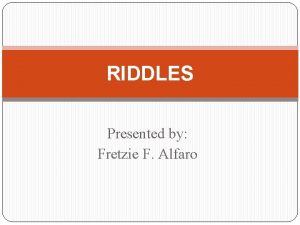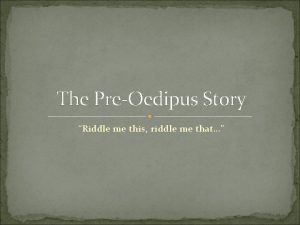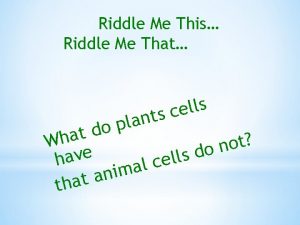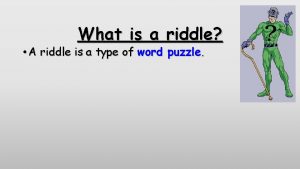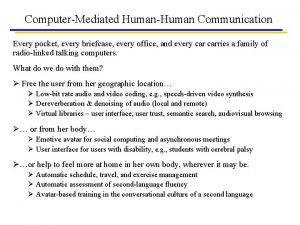The Science of Cells Riddle What is every

























































- Slides: 57

The Science of Cells

Riddle: What is every color, is on you, in you, and all around you, is both very large, and very small, can be eaten, and can eat you?

LIFE

Life Look around you. What do you see? A classmate, a brother or sister? Look out the window, or go for a walk. You will see trees, grass, plants, dogs, cats, bugs, and many other forms of life

Life is all around us… From many kilometers (miles) into the atmosphere, to many meters (feet) beneath the surface of the Earth, life is everywhere. What is this stuff we call life? What are some things that all life forms have in common?

Cells These cells are the basic building blocks of life. As an example, have you ever seen a sand castle?

Cells At a distance, the sand castle looks like a smooth brown building. As you get closer to the sand castle, you can begin to see that it is not one smooth building, but instead that it is made up of millions of tiny grains of sand.

Cells Looking at an elephant, you might see what looks like a smooth gray animal. And it is true that this is what you are seeing. However, just like the sand castle, if you could get close enough, and if your eyes were powerful enough, you would realize that what looks like a smooth gray surface, is really made up of many billions of smaller objects called cells.

Cells are tiny units of living materials separated by a cellular wall, or barrier. These cells are so small, that they can only be seen with a powerful tool known as a microscope. Cells make up every part of a living thing. Your skin, your hair, fingernails, blood, bones, nerves, and muscles are all made up of cells. These cells work together to keep the life form alive.

Tissue A tissue is a family of cells that live very close together, and work hard to do the same jobs. Many tissues come together to form what biologists call an organ. This is like a city in the example below. Organs then work together to form a system, and eventually the entire body of a life form.

Your body In a way, your body is functioning as a mini-planet. Right now within your body, there are billions of individual cells working hard in specialized jobs. These cells join into tissues, organs, and systems and help make up a vast community of life within you.

History of cells You are very fortunate to have been born when you were. Throughout most of human history, scientists knew very little about life, and how it works. It was not until 1665 that a scientist by the name of Robert Hooke first discovered the existence of cells.

History of cells While using the newly invented compound microscope to look at a thin slice of cork, Hooke saw tiny room like structures that he named cells. The cells that Mr. Hooke saw through his microscope were all dead, because the cork came from a plant that had long since died.

History of cells Nearby a Dutch scientist by the name of Anton Van Leeuwenhoek was also using his microscope to look at things. Anton Van Leeuwenhoek decided to try and look at things that were still alive, like blood, and saliva from his mouth. Mr. Leeuwenhoek all looked at rainwater through his microscope.

History of cells What did Anton Van Leeuwenhoek see through his microscope? He was surprised to find what looked like tiny animals. He named these animals “animalcules”.

Cell Theory Today scientists have developed what we call the Cell Theory. This theory states the following: ◦ All living things are made of cells. ◦ Cells are the basic units of structure and function in living things. ◦ Living cells come only from other living cells.

What’s inside a cell Inside a cell are tiny organs called organelles The word organelle is a big word that means small organ. These organelles function to provide for the needs of the cell. They work to bring in food supplies, get ride of waist, protect the cell, repair the cell, and help it grow and reproduce.

Cells vary in size, your body cells range in size from 5 -20 um. Cells are small because: ◦ They must function efficiently. Cell size is limited by two factors: ◦ Surface area-to-volume relationships that make distribution of materials throughout a large cell difficult; ◦ The volume of cytoplasm the nucleus can control.

Cells Most cells are small because larger cells do not function as efficiently ◦ larger cells are more difficult to control because of the distances involved from the command center at the core to the peripheral regions ◦ organisms that are comprised of many, small cells are at an efficiency advantage over organisms comprised of few, larger cells

Plant cell The first cell structure we will explore is the cell wall. Found only in plant cells, the cell wall provides the cell with additional strength. Cell walls are thick walls built around the cell. These walls are made from cellulose.

Animal cell Enclosed by a plasma membrane and containing a membranebound nucleus and organelles. Can’t make their own food The animal cells use the food to make the energy they need to reproduce and carry out basic functions. This process takes place in a part of the cell called the mitochondrion.

Animal versus plant cells Only Animals cells Centrioles (helps in cell division) Only Plant Cells A single, large vacuole ( up to 90% of volume). Cell Wall surrounding the plasma membrane (made of cellulose). Chloroplast (contains chlorophyll for photosynthesis). Brick-like shape (due to cell wall). The main difference is that animal cells only have a cell membrane, while plant cells have a cell wall and cell membrane.

Typical animal cell Typical plant cell • Nucleus • Nucleolus (within nucleus) • Rough endoplasmic reticulum (ER) • Smooth ER • Ribosomes • Cytoskeleton • Golgi apparatus • Cytoplasm • Mitochondria • Vesicles • Lysosomes • Centrosome • Centrioles • Nucleus • Nucleolus (within nucleus) • Rough ER • Smooth ER • Ribosomes • Cytoskeleton • Golgi apparatus (dictiosomes) • Cytoplasm • Mitochondria • Vacuoles • Cell wall Organelles

Why do plants have cell walls, and not animals? Think about how a plant grows. Plants grow tall, towards the Sun's light. In order to provide plants with the strength necessary to support their weight, the cells within the plant have this hard cell covering. If a tree were soft and mushy like an animal, do you think they could stand strong and tall?

What would happen if the cells in your body had cell walls? If an animal's body were made of plant cells, the animal would be very stiff, and unable to move easily. Instead of cell walls, animals use other creative solutions to give them strength. For example, many animal's bodies are built on a structure of bones. These bones allow the animal to have the strength to stand up, but the flexibility to move quickly.

Kinds of Cells Two types of cells: ◦ Prokaryotic ◦ Eukaryotic

Prokaryotic Cells Lack a nucleus Do not have an extensive system of interior membranes or compartments No organelles (membrane bound compartments) Have ribosomes (protein production) Ex. Bacteria

Prokaryotic Cells Other structures sometimes found in prokaryotes relate to locomotion, feeding, or genetic exchange ◦ flagellum (plural, flagellae) is a threadlike structure of protein fibers that extends from the cell surface may be one or many aids in locomotion and feeding ◦ pilus (plural, pili) is a short flagellum aids in attaching to substrates and in exchanging genetic information between cells

Eukaryotic Cells Eukaryotic cells are larger and more complex than prokaryotic cells ◦ have a plasma membrane encasing a cytoplasm internal membranes form compartments called organelles the cytoplasm is semi-fluid and contains a network of protein fibers that form a scaffold called a cytoskeleton

Eukaryotic Cells many organelles are immediately conspicuous under the microscope ◦ nucleus a membrane-bounded compartment for DNA that gives eukaryotes (literally, “true-nut”) their name ◦ endomembrane system gives rise to the internal membranes found in the cell each compartment can provide specific conditions favoring a particular process

Eukaryotic Cells not all eukaryotic cells are alike ◦ the cells of plants, fungi, and many protists have a cell wall beyond the plasma membrane ◦ all plants and many protists contain organelles called chloroplasts ◦ plants contain a central vacuole ◦ animal cells contain centrioles

Plasma Membrane All cells are surrounded by a plasma membrane composed of a bilayer of phospholipids. The polar ends of these phospholipids interact with the interior and exterior fluid environments of the cell and the nonpolar fatty acid chains form the interior of the membrane.

Plasma Membrane Proteins within the membrane: ◦ Transmembrane proteins: function as transport mechanism across the membrane. ◦ Cell surface proteins: serve as identification markers in cell communication. Membrane defects can cause disease such as cystic fibrosis (chloride ion transport not carried out correctly)

The Plasma Membrane A phospholipid has a polar head and two nonpolar tails The polar region contains a phosphate chemical group and is watersoluble The nonpolar region is comprised of fatty acids and is water-insoluble Figure 5. 4(a) Phospholipid structure

The Plasma Membrane A lipid bilayer forms spontaneously whenever a collection of phospholipids is placed in water Figure 5. 5 The lipid bilayer.

The Plasma Membrane The interior of the lipid bilayer is completely nonpolar ◦ no water-soluble molecules can cross through it ◦ cholesterol is also found in the interior it affects the fluid nature of the membrane its accumulation in the walls of blood vessels can cause plaques lead to cardiovascular disease

Cell Membrane Found in both plant and animal cells, the cell membrane is the outside wall of a cell. In plant cells, it is a second wall, and is found just inside the main cell wall. The cell membranes found in animal cells contain a chemical called cholesterol. This chemical makes the membrane harder. Plant cells do not need cholesterol, because they have a cell wall, as a result, their cell membranes are softer.

Cell Movement In order for a cell to remain healthy, the cell needs to be able to bring in food, and get ride of waste. Look closely at this picture. You will notice that the cell membrane has small openings or doorways. These openings allow the cells to move materials in and out of the cell.

Cytoplasm As you travel through the cell membrane and enter the cell, you will find yourself floating in a kind of jelly. This jelly that fills the inside of a cell is called Cytoplasm helps to hold the cell's organelles (small organs) in place.

Cytoplasm also gives the cell structure. Think of a balloon. An empty balloon does not have much structure. However, if we fill it with something, like water, it begins to take shape. Cytoplasm also helps the cell move proteins, chromosomes and other materials including the cells organelles around the cell.

Endoplasmic Reticulum How do you travel from home to school? Do you take a road, or sidewalk? Roads and sidewalks give people a path to follow as we move about our cities. A cell also has a system of tiny roads. These roads are actually tubes called the Endoplasmic Reticulum.

Endoplasmic Reticulum These clear tubes travel throughout all parts of the cell. Some go from the nuclear membrane to the outside cellular membrane. Others travel to different organelles. Throughout the cell, the endoplasmic reticulum carries materials where they need to go.

Ribosomes As you travel along the endoplasmic reticulum you will notice that stuck to the side of this tube, are several small balls called Ribosomes use available materials to build proteins. These proteins can then be used by the cell for other purposes, such as to build new structures, repair damage, and direct chemical reactions.

Ribosomes Why do you think ribosomes are found on the walls of the endoplasmic reticulum? Think about it. Remember, the endoplasmic reticulum is the cell's transportation system. When a ribosome is done building a protein, it can release it directly into the endoplasmic reticulum, where it can then be transported to wherever it is needed.

Lysosomes As you travel through the endoplasmic reticulum look out into the cytoplasm. You will see small round objects called Lysosomes are filled with enzymes that are used to break up and partially digest food. The food particles are broken up into smaller pieces, which can then be passed on to another organelle called mitochondria. We will learn about the mitochondria shortly.

Lysosomes Another important job that the lysosomes perform is to breakdown and digest older parts of a cell. As a cell ages, parts of it need to be replaced. The lysosomes breakdown the old parts, so that the materials can be reused to build new parts.

Mitochondria The organelle responsible for energy production inside a cell is called a Mitochondrion (Plural: Mitochondria). These pill shaped organelles take food, and break it apart into water and carbon dioxide. As food is broken down, an enormous amount of energy is created.

Mitochondria Think of the power generators that produce electricity for our cities. As these power generators break up fuel, they create electricity which is captured, and transmitted throughout the city. Within living things, cells which are more active need more energy. As a result, these cells have more mitochondria. In a similar way, bigger cities need more power, and as a result, these cities have more power plants.

Golgi Apparatus The Golgi Apparatus is responsible for taking the proteins which were created by the ribosomes, and making them bigger and better. Think of an assembly line, where cars are made. The first worker creates a car frame. The next worker adds an engine, or seats, or other parts.

Golgi Apparatus Ribosomes are like the first worker in the pic. They create basic proteins. The golgi apparatus then takes these proteins and adds to them, making them bigger and better. When the golgi apparatus is done, it releases the new proteins into the cell, where they can be used to strengthen and build up the cell.

Vacuoles & Chloroplasts Vacuoles are small sacs are filled with food and water. They are used by cells as storage tanks. All plant cells have vacuoles, but not all animal cells do. The primary place where plants store water is within its vacuoles. When a plants vacuoles are filled with water, they become plump, giving the plant strength. What happens when you do not water a plant? It begins to wilt, becoming softer. This is because the vacuoles found inside the plants cells are running out of water.

Vacuoles & Chlorplasts When you look at a plant, what color do you most often see? What makes plants green? The last organelle we will explore is the Chloroplast. A chloroplast is a small pill shaped organelle found only in plants. Chloroplasts are green because they are filled with a green pigment, or chemical called Chlorophyll is used by a plant to capture energy from the sun, which can later be used to create food.

Why Are Cells Important for Living Organisms? All living things are made of cells. Cells make up all of the parts of an organism and are responsible for everything that goes on inside the organism. Cell theory explains the connection between cells and living things.

Cell Theory 1. All organisms are made up of cells. 2. Cells are the basic units that form the structure and carry out the functions of all organisms. 3. Cells are formed only from other cells. 4. Cells contain the genetic instructions of organisms. 5. Cells control the metabolism and biochemistry of organisms.

Structure Complex organisms are made up of billions of tiny cells. The structure of an organism depends on the way its cells are arranged. The variety of ways that cells are put together accounts for the biodiversity of organisms.

Function Cells are involved in all the processes in an organism's body and carry out the fundamental activities that make life possible. Cells absorb nutrients and water, aid in digestion, growth, production of biological molecules, secretion, respiration, excretion of wastes, generation of a membrane potential or voltage, response to stimuli and reproduction.

Genetic Material The cell's nucleus acts like a brain to control all of the cell's functions. Within the nucleus are thin strands of genetic material that contain the instructions for directing all of the cell's activities. Genetic information is passed from one generation of cell to another when cells divide.
 Tigmo tigmo agokoy ugma ra kita mag asoy
Tigmo tigmo agokoy ugma ra kita mag asoy Every nation and every country
Every nation and every country Microsoft empower every person
Microsoft empower every person Every knee shall bow every tongue confess
Every knee shall bow every tongue confess Every rotarian every year
Every rotarian every year Every nation and every country
Every nation and every country Every picture has a story and every story has a moment
Every picture has a story and every story has a moment Every child every day
Every child every day Computer science riddle
Computer science riddle Olfactory groove keros classification
Olfactory groove keros classification Papillary duct of bellini
Papillary duct of bellini Pineal gland
Pineal gland Haploid and diploid venn diagram
Haploid and diploid venn diagram Somatic cells vs germ cells
Somatic cells vs germ cells Chlorocruorin
Chlorocruorin Prokaryote vs eukaryote cells
Prokaryote vs eukaryote cells Animal cell venn diagram
Animal cell venn diagram Prokaryotic cells
Prokaryotic cells Organelle trail
Organelle trail Masses of cells form and steal nutrients from healthy cells
Masses of cells form and steal nutrients from healthy cells Pseudostratified vs simple columnar
Pseudostratified vs simple columnar What cell type
What cell type Which organisms are prokaryotes
Which organisms are prokaryotes Nondisjunction in meiosis
Nondisjunction in meiosis Cell substance
Cell substance My favorite subject
My favorite subject Hình ảnh bộ gõ cơ thể búng tay
Hình ảnh bộ gõ cơ thể búng tay Slidetodoc
Slidetodoc Bổ thể
Bổ thể Tỉ lệ cơ thể trẻ em
Tỉ lệ cơ thể trẻ em Voi kéo gỗ như thế nào
Voi kéo gỗ như thế nào Glasgow thang điểm
Glasgow thang điểm Bài hát chúa yêu trần thế alleluia
Bài hát chúa yêu trần thế alleluia Các môn thể thao bắt đầu bằng tiếng đua
Các môn thể thao bắt đầu bằng tiếng đua Thế nào là hệ số cao nhất
Thế nào là hệ số cao nhất Các châu lục và đại dương trên thế giới
Các châu lục và đại dương trên thế giới Công thức tính độ biến thiên đông lượng
Công thức tính độ biến thiên đông lượng Trời xanh đây là của chúng ta thể thơ
Trời xanh đây là của chúng ta thể thơ Cách giải mật thư tọa độ
Cách giải mật thư tọa độ 101012 bằng
101012 bằng độ dài liên kết
độ dài liên kết Các châu lục và đại dương trên thế giới
Các châu lục và đại dương trên thế giới Thể thơ truyền thống
Thể thơ truyền thống Quá trình desamine hóa có thể tạo ra
Quá trình desamine hóa có thể tạo ra Một số thể thơ truyền thống
Một số thể thơ truyền thống Cái miệng bé xinh thế chỉ nói điều hay thôi
Cái miệng bé xinh thế chỉ nói điều hay thôi Vẽ hình chiếu vuông góc của vật thể sau
Vẽ hình chiếu vuông góc của vật thể sau Biện pháp chống mỏi cơ
Biện pháp chống mỏi cơ đặc điểm cơ thể của người tối cổ
đặc điểm cơ thể của người tối cổ Thế nào là giọng cùng tên?
Thế nào là giọng cùng tên? Vẽ hình chiếu đứng bằng cạnh của vật thể
Vẽ hình chiếu đứng bằng cạnh của vật thể Fecboak
Fecboak Thẻ vin
Thẻ vin đại từ thay thế
đại từ thay thế điện thế nghỉ
điện thế nghỉ Tư thế ngồi viết
Tư thế ngồi viết Diễn thế sinh thái là
Diễn thế sinh thái là Dot
Dot
